Learning proper knife skills is critical to your success and safety in the kitchen.
I’m going to be honest, when I first started cooking I did not have appropriate knowledge about kitchen knives and had maybe 2 that I used for everything. You guessed it, they didn’t work well and had never been sharpened. EVER. Looking back, I’m amazed that I was able to cut anything accurately or in a safe manner.
Here’s the bottom line, if you want to improve your cooking skills we must start at the basics of using kitchen knives.
Let’s get started!
This post is part of our Basic Cooking Skills series. Each week we will be doing a deep-dive into one basic cooking skill and a brand new recipe to accompany it to practice that newfound skill. Check back throughout the series for updates and new posts.
Please note this post contains affiliate links, which means I receive a small commission, at no extra cost to you, if you make a purchase using the links. Please see my disclosure for more details.
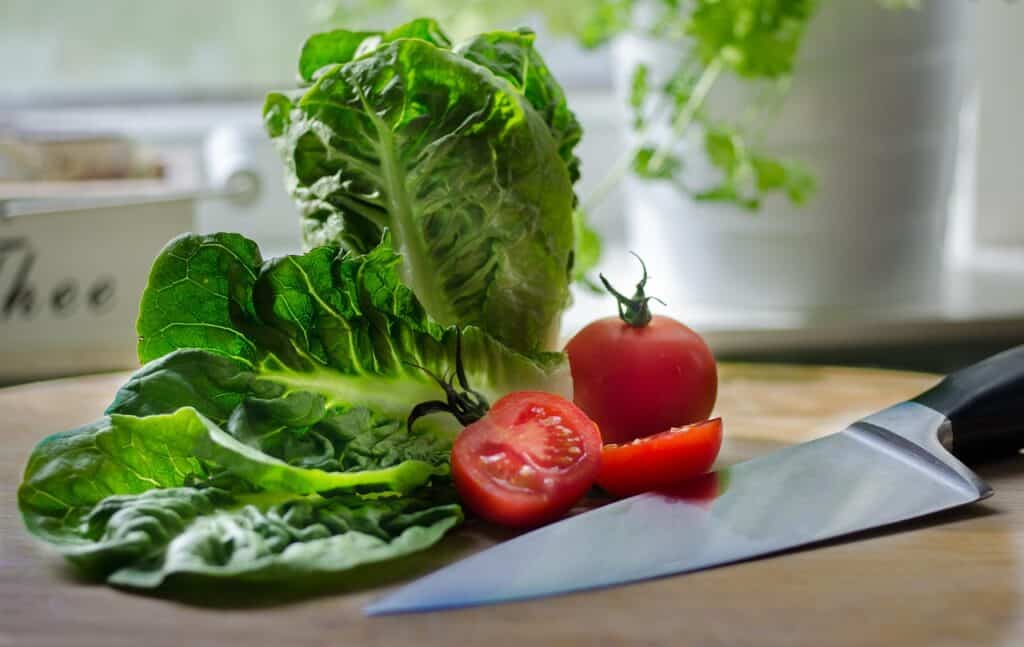
The importance of knife skills
Informing yourself about proper knife techniques will not only increase your confidence and understanding of cooking but will allow you to maintain safe practices and improve your efficiency.
Adequate chopping skills leads to uniformly cut pieces, which leads to even cooking and better overall meals.
Successfully cutting a vegetable will increase your confidence in the kitchen and decrease the time it takes you to prepare a meal.
Learning about cuts of vegetables will help you comprehend recipes fully and understand details provided by the authors.
Knowing the functions of different knives will make your role as the cook even easier and alleviate the difficulty of some tasks.
Finally, and arguably most importantly, upholding safety measures establishes an inviting, secure space in your home for the whole family to enjoy.
knife safety
It’s extremely important to practice safe knife skills to prevent any injury. Briefing yourself on basic rules and proper techniques is imperative to protect yourself from injury.
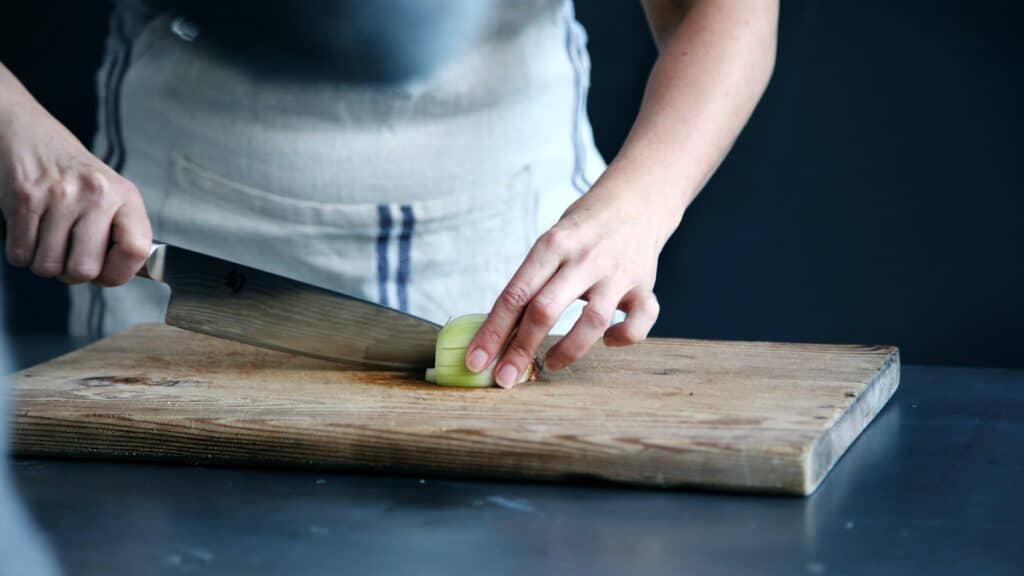
Basic Rules
- Cut on a stable surface with a cutting board.
- Take your time
- Maintain a sharp knife blade
- Do not leave knives near the edges of counters or tables
- If a knife falls, do not try to catch it
- When carrying a knife, keep the point down and the blade turned away from you.
- Instead of passing a knife to someone, set the knife down on your workspace and let them grab it.
how to: hold a knife

Begin by wrapping your fingers around the handle and holding the top of the knife between your thumb and forefinger. This gives you a firm grip and more control when you’re chopping.
As you’re chopping food, try not to lay your other hand out flat. Rather, curve your fingers inward like a claw to hold what you are chopping. Your knuckles can help guide your knife and protects your fingertips.
Cuts are made from the front of the knife to the back in a gliding motion. Holding and chopping properly will take some time and lots of practice.
how to: sharpen a knife
Dull knives are dangers waiting to happen. A dull knife does not cut as smoothly and requires more force on your part, increasing the change of slippage and injury.
There are a few options available to sharpen your knife at home. Let’s walk through a few of them and look at pros and cons of each
sharpening steel

Usually included in knife sets, a sharpening steel is a long narrow rod with a thick handle. This steel rod realigns the edges of dull blades. It takes a little bit of coordination to use but you’ll be sharpening knives in no time!
Held on the counter directly upright with one hand, hold a knife in your dominant hand at a slight angle (15 degrees to be exact).
Press the part of the blade near the handle lightly near the top of the metal rod. Begin sliding the blade down the rod and towards the tip of the knife in a long sweeping motion.
Repeat up to 10 times on each side, or until the knife is sharp. If your knife is extremely dull you’re better off using either of the 2 options below.
Manual knife sharpener

Manual knife sharpeners can be found at low prices in most kitchen stores and can be pretty compact, making for easy storage.
It sits on your counter and has V-shaped slots for the knife blade. With your dominant hand holding the knife and your other steadying the sharpener, set the part of the blade near the handle into the slot.
Applying a little bit of pressure, pull the knife completely through the slot. Repeat as many times as needed.
There are also electric knife sharpeners that are fairly easy to use. The machine does the work for you, but it comes with a big price-tag.
types of knives and their uses
There are numerous different kinds of knives available, but I’ve broken down some of the popular ones into a few categories: The Essentials – knives I think everyone should have in the kitchen; Nice-To-Haves – knives that aren’t needed to get started but great supplements; Not Necessaries – knives that advanced cooks may have but most home kitchens probably won’t.
the essentials
- Chef’s knife – commonly used, longest knife, used most often for chopping meat and slicing and dicing veggies, easy to control gliding back and forth. (Luke’s most used knife)
OR
- Santoku knife – my go-to knife in the kitchen. A Japanese version of the chef’s knife. Usually shorter and thinner than a chef’s knife, not as heavy. Santoku means = three virtues (slicing, dicing, mincing)
- Steak knife – a spruced up table knife that is usually serrated for cuts through meat or fish during meals
- Bread knife – long and narrow, always serrated, used for cutting bread without squishing the bread. Also good for fluffy cakes
nice-to-haves
- Kitchen shears – kitchen scissors, great for meat or herbs, stronger and sharper scissors
- Paring knife – known for precision, a small knife with a pointy tip that is good for cutting and peeling fruit and vegetables easily.
- Utility knife – a slightly smaller knife than a chef’s knife, smaller cuts, sturdier, good for cutting meat and vegetables that may be too small for a chef’s knife
not necessary for casual cooking (IMO)
- Boning knife – used mostly when removing meat from the bone, i.e. a whole chicken or fish. Much smaller, very precise cuts
- Cleaver knife – very bulky and heavy, large rectangular blade, used for chopping thick pieces of meat, cutting through bones
basic cuts of vegetables
The more I research this, the more knife cuts I discover! I’ve gathered what I feel are the most used cuts that would benefit a novice cook.
Proper cuts of vegetables enhance the presentation of your food and will increase your understanding of knife skills
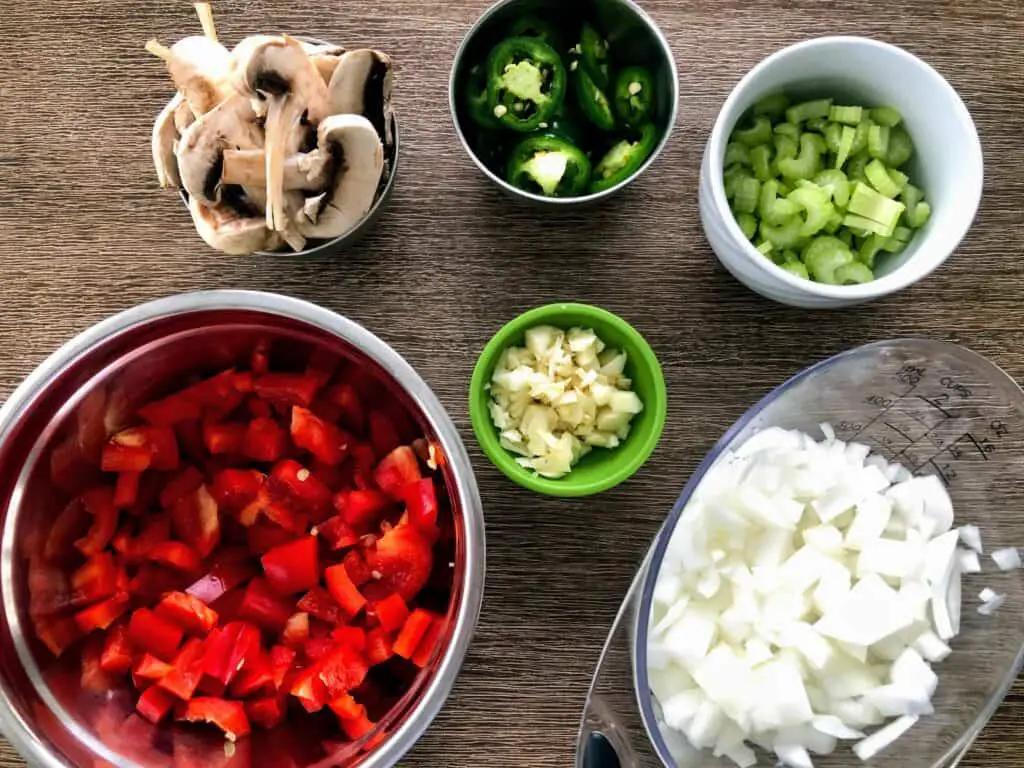
Most of the names are French but try not to be intimidated! The cooking world is filled with French influence and these methods have held fast to their French roots.
(First and foremost, when cutting fruits and vegetables that are round slice so there is a smooth side to lay down flat and keep it steady)
common vegetables cuts
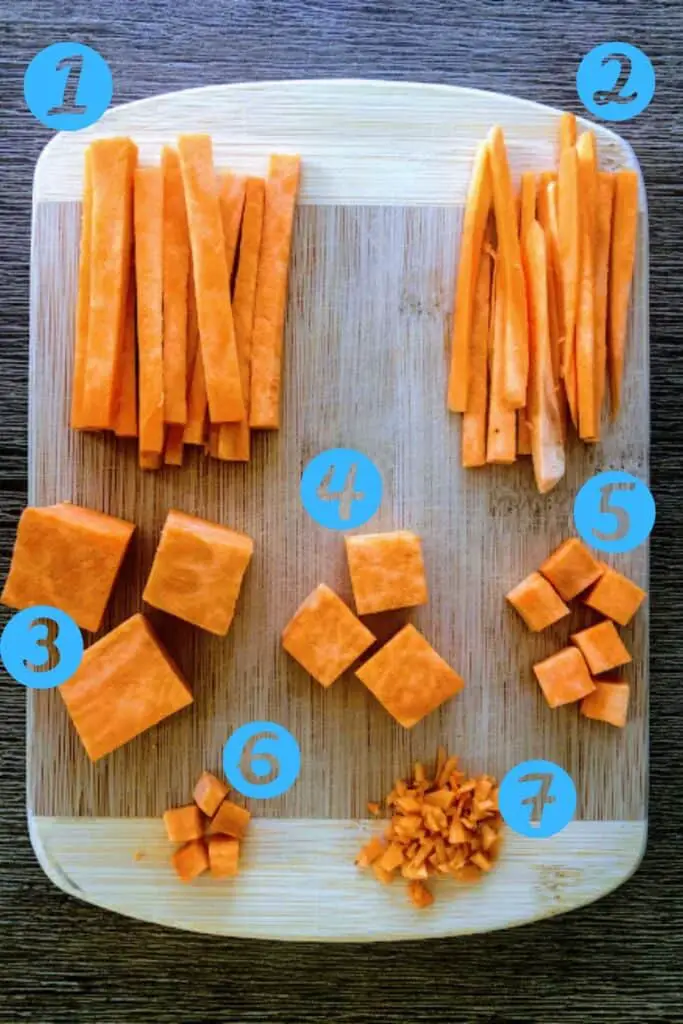
Let’s start with the large cuts and work our way down.
- (1) Batonnet “little stick” – this cut is standard and often used before moving on to other cuts. Batonnet cuts are long and thin, about ¼ inch on the side.
- Chiffonade – similar to Batonnet but for herbs and vegetable leaves. Stack and roll the leaves, then cut horizontally into thin strips. Think of a garnish of basic on pasta or a salad.
- (2) Julienne/Alumette “matchstick” – take the Batonnet cuts and make them even thinner! Long and super thing, about 1/8 inch on each side. Perfect for salads!
- Dice
- (3) Large – cubed cuts, almost an inch on each side. Perfect for heart stews and for large produce that need to be cut (potatoes, watermelon)
- (4) Medium – slightly smaller cubed cuts, about ½ an inch on each side. Perfect for soups or tomato sauces. This is the typical size you can expect when a recipe calls for something to be diced.
- (5) Small – break it down even smaller to cubed cuts about ¼ of an inch on each side. Perfect for mirepoix, the foundation of soups, and salsas.
- (6) Brunoise – even smaller than a small dice is brunoise. Take your julienne strips and cut into cubes. These small cuts are seen in salsas or sauces.
- (7) Mince – breaking the cuts down even smaller to a mince. This cut is very fine and is commonly used for garlic or onions. Very small cuts like a mince create a much stronger taste.
implement your new skill
Grab a variety of extra produce you have lying around and experiment with your various knives. Try to get a good feel of how they are different and what’s most comfortable for you on different fruits and veggies.
If you’re feeling brave, test out your skills and try some of the different cuts of vegetables!
This upcoming Thursday I will be posting an amazing recipe to follow and put your newfound knowledge to the test. Be on the lookout! This post will be updated with a direct link at soon as it’s available.
****Update Alert! Find the full recipe available here!
Pin me!
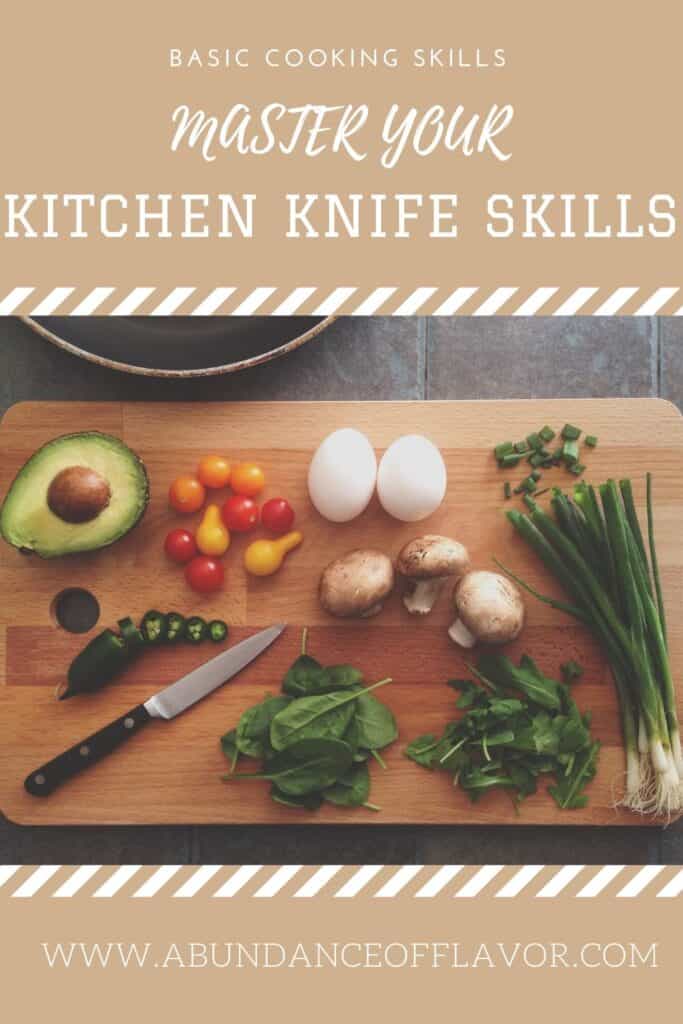
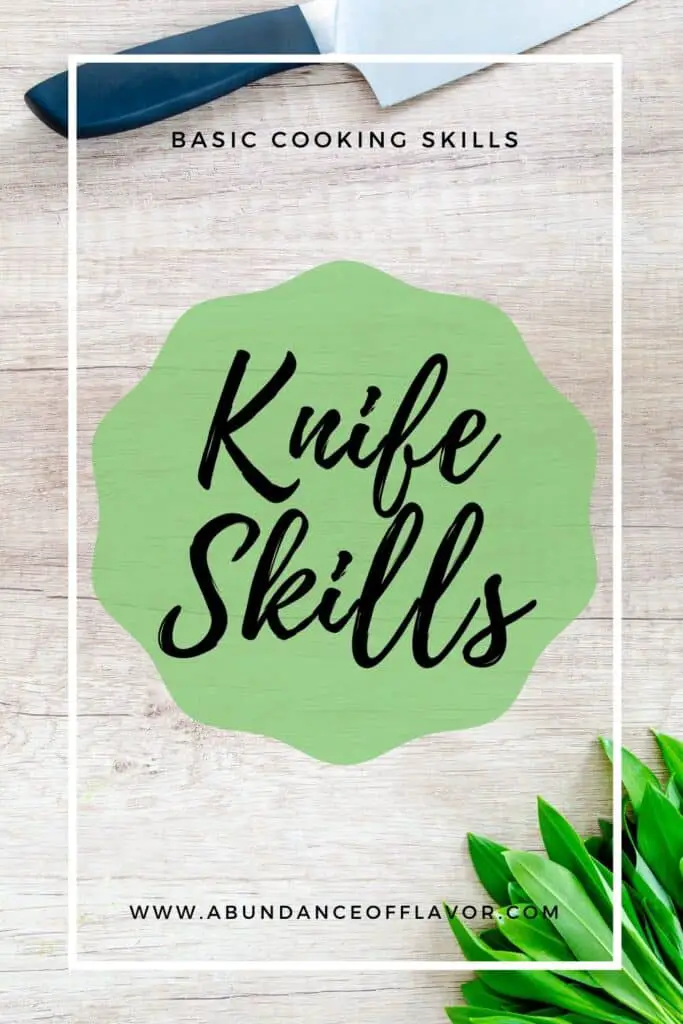
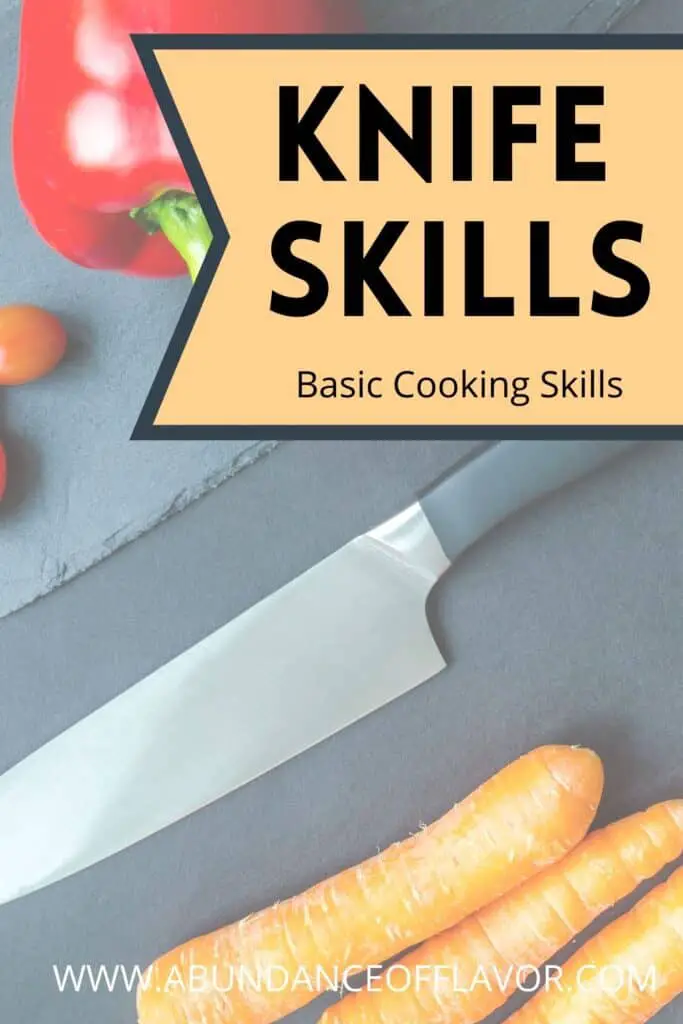
Now the important question, Chef or Santoku?? Share your favorite kitchen knife and any other tips in the comments below!



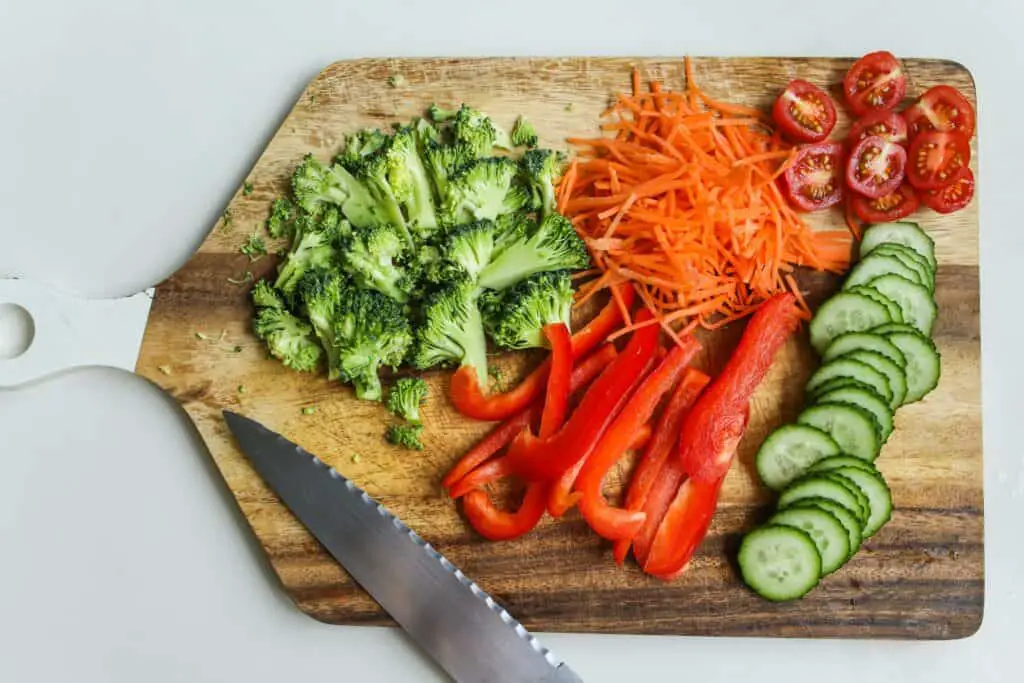
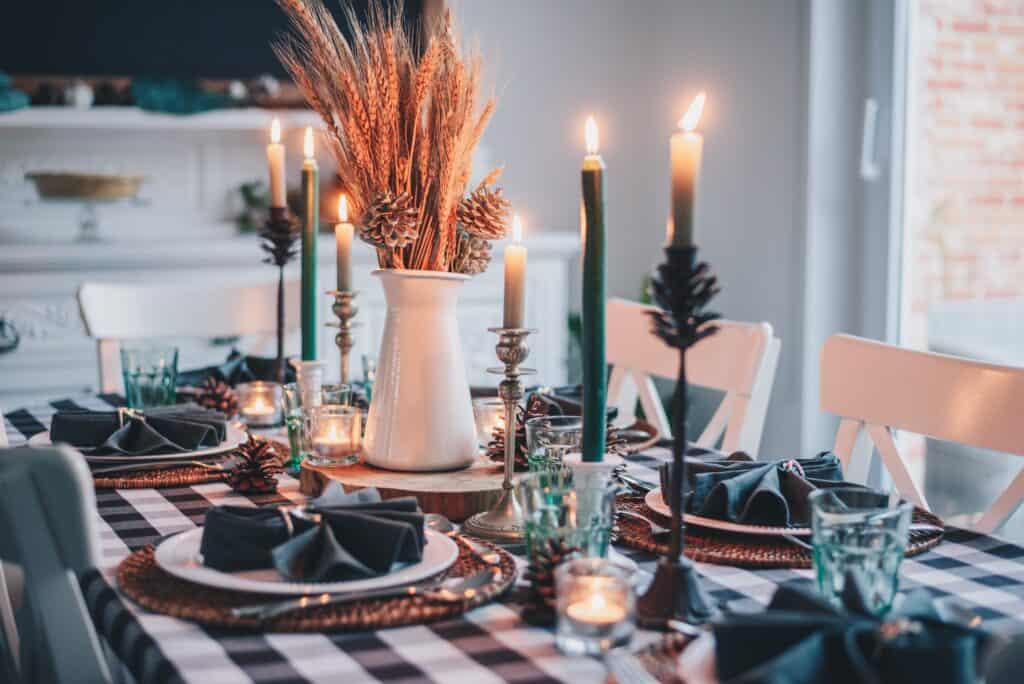
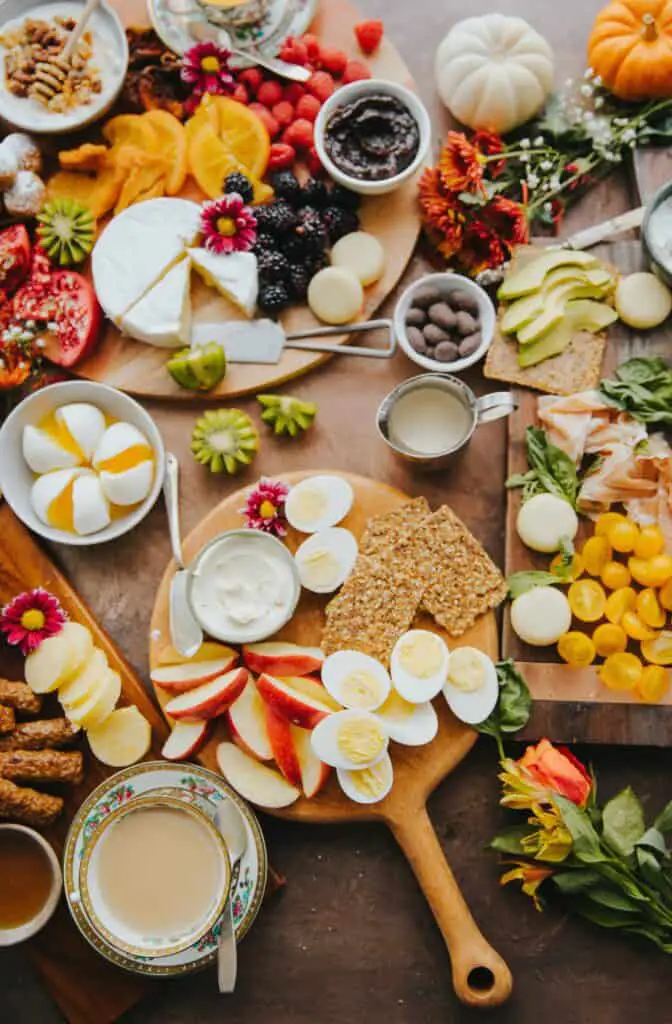

I’ve been enjoying cooking while in isolation but one thing I definitely don’t have down are the chopping skills! Thanks for this.
For the longest time, I held my knife wrong. Once I got it right, it was much easier and safer to cut.
I also love that you have included a handy list of knife cuts!
Wow the cuisine can really become an art with the modes
of cutting the vegetables..
It really is amazing! I love learning how deep French culture is intertwined with the cooking world
This post was so interesting and helpful! Although I love baking I am useless at cooking I normally leave it to my partner but I had no idea there were so many different types of knife and ways to cut vegetables!
I’m glad it was helpful and hope you learned something new 🙂
I usually leave my partner to cook but in quarantine I thought I’d learn a new skill. (I was just terrified of giving him food poisoning) & this post is definitely so helpful! Starting to enjoy it more and more. Thank you for sharing! X
That’s such great news! I hope your enjoyment of cooking continues to grow!
i’VE been working on my knife skills in quarantine because my foods class teacher assigns so much for us to do with making meals. this is helpful.
That’s great! I’d love to hear more about your class, I love taking cooking classes.
Great post. Very informative and helpful. Definitely going to use these tips to sharpen my knife skills.!
Ha I see what you did there 🙂 Thanks for the feedback!
Pingback: Baked Sweet Potato Fries - Abundance of Flavor
Very helpful post! especially to me nowadays since I’m doing a lot of cooking since the lock-down! Thanks for sharing
I’m so glad it’s helpful! I too have been going overboard with cooking and baking during quarantine!
I am teaching my daughter to cook. I am saving this for her to read later. Great post!
That’s so great to hear! I hope it will be helpful for her!
This is a great tutorial! I can’t count how many chunks of fingers I’ve lost to poor knife skills over the years.
It’s so easy for that to happen at the slip of a knife! I hope it’s helpful for the future
Great resource! I need to work on my knife skills.
Thanks so much! I’ve been practicing with all my free time at home 🙂
This is very helpful! I’m totally guilty of using only 1 or 2 knives in my set and need to work on my chopping skills. I also haven’t sharpened them in a long time, so this is a great reminder!
It’s so easy to neglect sharpening your knives, I could be better about it too!
Pingback: Mexican Sauteed Vegetables - Abundance of Flavor
Pingback: Roasting Vegetables - Basic Cooking Skills - Abundance of Flavor
Pingback: 21 Basic Cooking Skills for Beginners - Abundance of Flavor